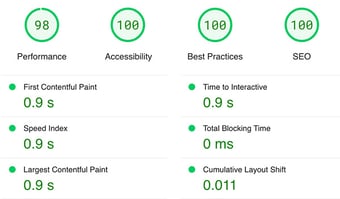Feedback Fatigue: What it is and how to fight it
Wonder what your customers are thinking? You’re a marketer, not a mind-reader. If your efforts to understand and solve your audience’s problems have...
Take full advantage of the new and improved HubSpot CMS experience with the CLEAN theme.
Have a question and looking for an answer? I've likely got a video for that or an article that covers it.
Google PageSpeed Insights is the gold standard in analyzing the speed and performance of a website. Here is how CLEAN Pro ranks. Not too shabby for a media-rich page.

Report generated: Tues, March 7, 2023, based on Home Page - Opt 1.
.jpg)
Wouldn't it be great if your clients were a breeze? If you loved working with them and they were thrilled with you too?
If you’re thinking heck YES, ask yourself: who would be your perfect customer?
You can’t push a magic button to have the client of your dreams delivered to your doorstep (not yet, anyway). But you can figure out who your ideal client is and up the odds of them finding your website. That’s where Ideal Customer Avatars come in. Keep reading to learn:
A semi-fictional representation of your ideal customer based on market research and data. Sometimes referred to as a Buyer Persona, your ICA isn’t an actual person but is inspired by a real person.
Say you’re a fiddle teacher and have a favorite student (we'll call her Fiona). You might think about what makes Fiona a good fit for your music studio and use her as a starting point for your avatar (we'll go through how to create your avatar in a minute).
Tempted to skip over the nitty-gritty of creating your avatar? You might want to reconsider. Your ICA can help you:
“If you don't know where you're going, you might not get there.”
These wise words are attributed to baseball legend Yogi Berra, and if he were around today, I bet he’d agree that his idea applies to finding the right customers, too.
How are you supposed to find your ideal clients if you don't know who you want your business to serve?
If you’re experimenting with a new product or idea, define your target customers to test product market fit and keep upfront costs low.
Don't be afraid to change your target audience as you go along, either. Who seems most excited about your product? Is it the same group of people you expected?
Marketing, sales, and customer service have different qualifying questions they may ask in their search for ideal customers.
For example, marketing might ask:
"Where do our customers spend time online? What queries do they search for in Google?"
Sales might ask:
“How urgent is this customer’s problem? What price range do they expect?"
Customer service might ask:
“What features do our customers love seeing in our product? What would make them so happy that they turn around and tell their friends about us?”
Each department's answers should fit with the same ICA. If Marketing believes their ICA is searching for easy, out-of-the-box website themes, but Sales thinks their ICA wants to hire a fancy website developer, the two departments will work against each other.
Knowing who's NOT a fit for your business is just as important as knowing who is. A bad fit might be unhappy with you and discourage other folks from buying your product. That’s the last thing you need!
Let’s go back to our all-star music student, Fiona. Here’s how you might think about creating an ideal customer avatar using her as an example.
Fiona is 45 years old, married, and has 3 dogs. She makes roughly $100K/year.
Fiona is a foodie and music lover, especially rock and world music. The cool factor matters to her; she cares about looking good in the eyes of others. She prefers dogs to people and believes in supporting the arts.
Fiona takes her dogs on a walk every morning and snuggles up with them to watch scary movies in the evenings. Her frequent purchases include dog food (in bulk!), happy hour drinks at her favorite restaurants, and theater tickets.
Fiona needs music lessons to develop the technical chops to realize her retirement dream: to join the vibrant street music scene in New Orleans.
Pro Tip: AVOID categorizing ICAs by job title. Focus on your ICA’s wants, needs, and buying behavior. You'll drive more impact than if you were to group all business owners or marketing managers together.
For example, Fiona happens to be a marketing manager. But not all marketing managers want to play music.
Look at historical data and trends for your other customers, too, but be careful of averages. For instance, say you have 50 customers. 27 of them have two children each, 7 of them have 3 children each, and the remaining 16 have no children. If you take their average number of children, you'd end up with 1.5. Do you know anyone with 1.5 kids? Me either.
Remember, while your ICA is fictional, you still want them to be realistic.
The more you can humanize your avatar, the better. Think of and write to your ICA like a person to keep your marketing messaging relevant.
Tips for naming your avatar:
In Fiona’s case, she wants music lessons. More specifically, she wants to learn the fiddle.
Give your ICA a name with a ring to it. Here, we might choose something like Fiddler Fiona. Fun, right?
HubSpot recommends interviewing at least 15 people per ICA.
Start with these ideas for how to talk to your prospective (or current) customers.
After your interviews, you may have more questions. Don’t be afraid to create a hypothesis based on the info you already have, then keep your eyes peeled for patterns in behavior over time.
You bet! Use the Door Strategy to help your ICA self-select and direct your messaging toward one or the other. For example, Skooli, the online tutoring company, sells to two distinct groups: parents and students. However, they use different copy for each: Help your child achieve more (for parents) and Get better grades with online tutoring (for students).
Just be careful of too many ICAs. Focus on one (maybe two) to direct your resources and attract more of the right people.
Exciting! Start brainstorming the type of people you’d like to work with. What qualities, goals, or behaviors do they share?
Also, YES, you should still find real people to talk to. Who do you have in your network who might be willing to spend a few minutes chatting with you? Think of connections on LinkedIn or friends and family (if they match your ICA).
Here’s a sample outreach message you can customize:
“Hi, Fiona, I'm a fellow fiddler and recently stumbled upon your profile. So awesome that you want to bring more folk music to the streets of New Orleans. Thank you for being an integral part of keeping the arts alive!
I've been working on some ideas to help musicians like you master their technique, and I'd love to get your opinion. Do you have a few minutes in the next week or so to connect?
Please let me know either way. Thanks, and have a great rest of your day!”
This message will help you do a few things:
Introducing myself as a fellow fiddler tells this person we share something. She’ll be more likely to keep reading.
I show interest in her goals by naming them (bringing more folk music to the streets of New Orleans).
People love giving opinions (solicited and unsolicited). :) Ask, and you’re more likely to receive.
Remember to honor their time and follow up with a thank you email!
I’m gonna level with you: it doesn’t. Not to sound harsh, but as Jay Schwedelson says, “if you’re not known for something, you’re known for nothing.” Get honest about what your business does best, and focus your attention there.
As Abraham Maslow famously outlined, humans have many tiers of needs. Maybe your product doesn’t satisfy safety or physiological requirements (think housing or food), but it could fall into the self-actualization category (think self-help books or art classes). I’d argue that we have multiple needs in the latter category, and your product may help meet some of them.
Your ICA is the guiding star for your business. Before making a big decision, ask yourself, “which of these choices would be better for Fiddler Fiona?" You'll be more aligned with your customers and have a more successful business.
Also, remember that people change, industries change, and buying behavior changes. So should your ICA.
Revisit your ICA often, and bookmark this blog post for when you need a refresh.

Wonder what your customers are thinking? You’re a marketer, not a mind-reader. If your efforts to understand and solve your audience’s problems have...

Is HubSpot right for you? If you’re considering a new website, this platform is super easy to use and includes critical tools you need to grow your...

Is HubSpot worth the hype? You're about to learn why your fellow marketers love this platform, and which features could help you get the results you...